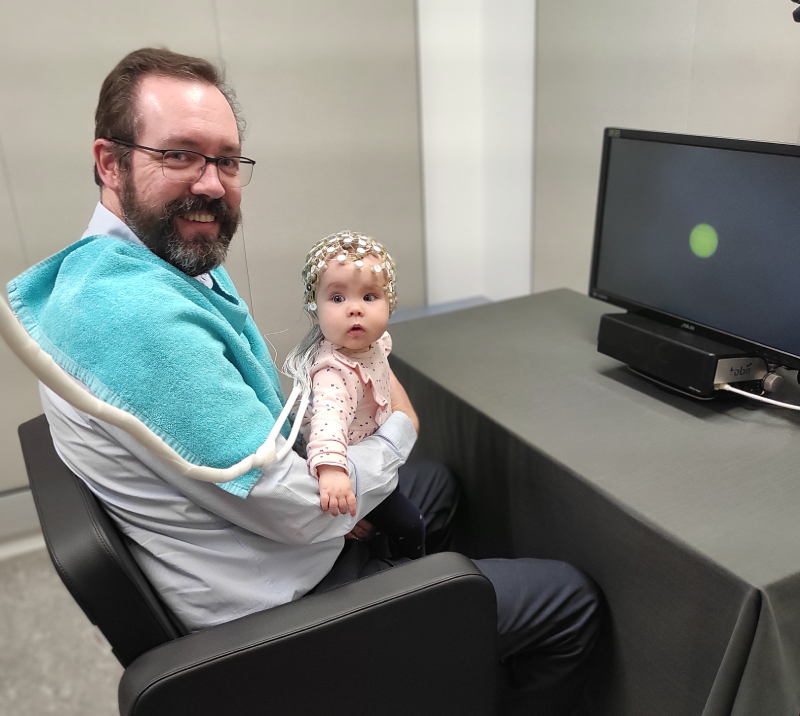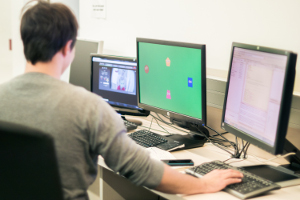Studies
When you arrive at the BabyLab, you’ll be greeted by the researcher who will accompany you and your baby to a room and explain, in detail, what the study consists of. For the study, your baby will sit on your lap and, depending on the procedure used in the research, the baby will watch some videos, hear some sounds or some words ... while we observe their natural reaction. Sometimes, the caregiver who is in the room with the baby, wears headphones with music or dark glasses (provided by the center) to avoid a possible influence on the baby's reactions.
If more than one person comes to the appointment with the baby, the other person(s) is outside the room, next to the researcher and they will be able to see the reactions of the baby while they perform the study. We also have games and books for siblings to play with.

Depending on the study, we will use different techniques to obtain the data. Next, we explain the most common techniques:
Eye-tracker
Eye tracking is used to determine precisely where the baby is looking at each moment. A camera connected to a special processor (eye tracker) remotely follows the eye movement and draws a "map" from which we know if the baby looks at the stimulus that is presented and how they explore the images that appear on the screen.
As in all our studies, the baby will be with the caregiver, father or mother, at all times, sitting on their lap and together they watch a short video. Afterwards, the researcher analyzes the "map" drawn by the eye-tracker to determine the points where the baby has focused their attention.
.
Electroencephalogram (EEG)
The Electroencephalogram (EEG) technique allows us to know, in a non-invasive way, the natural activity of the brain. It allows us to record the electrical activity of the brain, when different stimuli (images, sounds ...) are presented to the baby. We use a kind of "cap" that incorporates some small sensors with which we can record brain waves.
As in all our studies, the father or mother accompanies the baby at all times and once the researcher has put the "cap" on the baby, they sit on lab of the father or mother and together they watch a short video or listen to some sounds. Studies that use this technique usually last about 10 minutes..
Head-Turn Preference Procedure (HPP):
To carry out this type of study, manual coding is used, where the researcher is outside of the room and, with a video camera, observes the baby's reactions and records the times of the baby's responses.

We use the procedure of the preference of the head turn to study the capacity that the babies have to discriminate the contrasts in the auditory stimuli. The baby is sitting with his father or mother’s lap in from of three screens: one in front, one on the right and the third on the left. Included in the set up, are speakers behind the screens.
The study consists of two phases: a familiarization phase and a test phase.
In the familiarization phase, we present only one type of sounds, while in the test phase we present, at random, the same type of sound as in familiarization plus new types of sounds.
Along with the sounds in the familiarization phase: first, an image appears on the center of the screen to attract the baby's attention. Once the baby pays attention to this image, another image appears on one of the side screen, while the center image disappears. When the baby turns their head to the side, the auditory stimulus starts to play and will continue until they stop looking at the screen. After a certain amount of time repeating this process, we consider that the baby is used to this type of sounds and we move to the test phase. This second phase is similar to the previous one, but, incorporating the new type of sounds.
It is expected that, during the test phase, the baby will be more attentive to the stimulus presented if it is of the same type as those presented in the first phase.
Habituation - Looking time:
This type of study is similar to the HPP presented previously, but in this case, only a central monitor is used. Manual coding is also used, as in the previous case.
An image and simultaneously a type / category of sound are displayed on the screen. When the baby is bored and stops paying attention, the type / category of sound is changed. If the baby perceives it as new, they will pay attention again and will be attentive to the screen again. If they consider that it is the same type of sound… they will continue to be bored.
In this case, the measure taken is that of the time that they are attentive when the new type of stimulus is presented, which allows us to know if the baby perceives a difference between the groups of stimuli presented.
